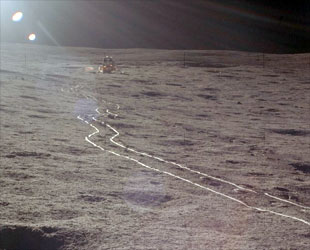NASA's Lunar Reconnaissance Orbiter was launched on June 18 as the United States' first return to the Moon in more than a decade. Journalist Leonard David with the Coalition for Space Exploration, a collaboration of space industry businesses and advocacy groups, provides this update on the mission and the plans to image the Apollo manned lunar landing sites.
Update for July 2:
Lunar Reconnaissance Orbiter (LRO) has returned its first photos: LRO's First Moon Images
Update for July 17:
Lunar Reconnaissance Orbiter has returned images of Apollo: LRO Sees Apollo Sites
July 1, 2009
— NASA's Lunar Reconnaissance Orbiter (LRO) is now undergoing checkout as it circles the Moon. Carrying a powerful imaging system, the LRO Camera, dubbed LROC for short, is being prepared for a roster of science-gathering and sharp-shooting duties — including the imaging of Apollo landing sites.
That's the word from LROC's Principal Investigator, Mark Robinson of Arizona State University in Tempe.
However, the resolution of any images of Apollo sites will not be as good as those made later during the probe's primary mapping orbit, a time when LRO will be at a lower altitude as it orbits the Moon, Robinson told the Coalition for Space Exploration.
The LROC Science Team has opened up a public request opportunity to suggest LROC Narrow Angle Camera targets using a public targeting tool.
Certain classes of targets are objects of intense interest to both NASA and the LROC Science Team and will be imaged extensively as part of a scientific investigation.
Variety of targets
Already in the request database are a variety of targets on the lunar surface, including the Apollo landing sites, Surveyor spacecraft, early Ranger impact points, Soviet lunar probes, and S-IVB rocket stage and lunar module ascent stage impact points.
Now undergoing checkout in Moon orbit, LRO is getting ready for its Moon charting mission.
"The LROC was activated yesterday and engineering data is being collected," explained Rich Vondrak, LRO Project Scientist. "The goal is to obtain the first images within the next week, hopefully as soon as this weekend."
As for imaging Apollo landing sites, Vondrak added: "We are evaluating the possibility of obtaining images of the Apollo sites before we reach our primary 50-kilometer mapping orbit. The ability to image Apollo sites depends on the satellite ground track and lighting conditions. If conditions are favorable and an image is made, it will promptly be released to the public."
Moonwalking mystery
The Apollo 15 and Apollo 16 landing spots are already on a list put together by NASA's Constellation Program Office, a Tier 1 "Regions of Interest" for the LROC.
Given the sharp-eyed Lunar Reconnaissance Orbiter, it is expected to peep in on the Apollo 11 site — the first human mission to the Moon back in July 1969. One large item that should be seen by LRO is Apollo 11's Eagle descent stage.
"You will definitely see this square thing sitting on surface — at low Sun we might be seeing the legs casting shadows," Robinson said. "Obviously we won't be able to see the stars on the flag," Robinson added. But there's also the prospect of sighting the tracks of the lunar buggies used in the Apollo 15, 16, and 17 missions.
And LRO may be able to clear up a little moonwalking mystery.

The tracks from a hand-pulled equipment cart could reveal just how close Apollo 14 moonwalkers got to Cone Crater. (NASA) |
"One of our many goals early on is to look at the Apollo 14 site and see if we can see exactly where they [the astronauts] were in the area of Cone Crater," Robinson said.
On Apollo 14, several of the planned geology stops were cancelled and the traverse stopped short of Cone Crater's rim. Post-mission analysis of landmarks in photographs indicated that the crew may have been just 65 feet (20 meters) from the crater rim when Mission Control ordered them to return to their lunar module. The crew did not know this during that moonwalk because of the difficulty in determining their precise location in the rugged terrain.
The preceding article was reprinted with permission of the Coalition of Space Exploration, where it first appeared.
